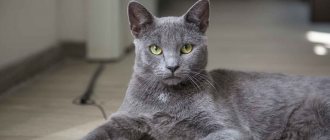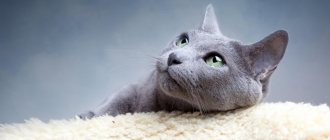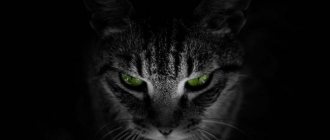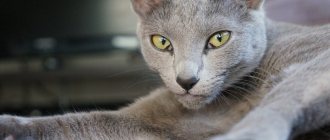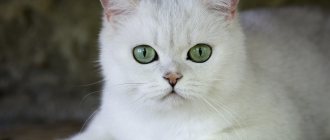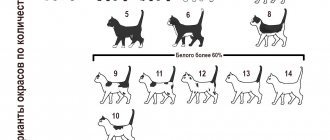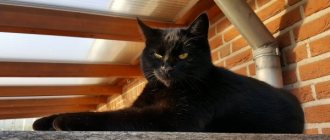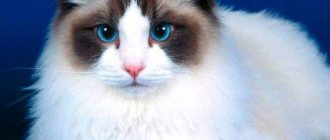Maintenance and care
Despite the fact that Russian Blue kittens are short-haired, caring for them is complicated by the presence of a thick undercoat.
You will have to comb the fur 1-2 times a week. It is best to use a furminator for these purposes. Combing should be done especially carefully during shedding. The breed is quite clean, so you can bathe the cat once every six months. But you should monitor the condition of your eyes and ears 2-3 times a month. If necessary, wipe away dirt using cotton wool soaked in water.
A cat's cleanliness is evident in all aspects of her life. The pet will not even come close to a dirty bowl or tray
Therefore, it is important to promptly change the filler and wash the dishes purr
So that the cat can throw out his energy and climb as high as possible, buy him a special house and place it on a hill. Otherwise, the animal will climb onto all the shelves and cabinets in the house - Russian blue cats love to watch what is happening from above.
How to choose and buy correctly?
A pure breed representative can only be found in a nursery. Choosing a kitten from random advertisements for sale is not difficult, but the risk of buying a pet that is not purebred or with genetic abnormalities increases. Before choosing, you should familiarize yourself with photos of pets of this breed, watch videos online, and study in detail the descriptions of the owners and reviews.
The baby is ready to move to a family at the age of 2-3 months.
Cat health
This is another indicator of the unprecedented popularity of the Russian Blue breed. They do not have any hereditary or congenital diseases. In most cases they have excellent health. There are also no special contraindications.
The only thing you need to keep an eye on is your diet. Only in cases of a balanced diet will the cat retain its predator instincts and be active throughout the day. Overeating has negative effects, just like any other animal.
When considering an animal for a country house, you should not forget about its teeth. Catching dirty mice can partly be a consequence of the development of various dental diseases. If you are unable to brush your teeth, you can turn to the so-called dental bones for help. They consist of durable fibers that effectively remove any plaque from the enamel.
Lifespan
Given the absence of any hereditary diseases, you can count on a life span of 12 years. Long-livers are those who have reached the age of 20. Old age usually proceeds in moderate activity.
Features of feeding
In general, cats of this breed are unpretentious in food. The only thing that requires especially close attention is the amount of iodine, carotene and other substances in the diet that can negatively affect the coloring of the animal. An excess of these elements in a pet's menu is unacceptable.
In our diet we give preference to meat and dairy products. In both cases, you should take care of the low fat content, because its presence can negatively affect the health of the pet. Suitable meats include beef, chicken, turkey, and fish. It is advisable to buy milk with a fat content of around 1.5-2%.
If you want to reduce the cost of feeding your Russian Blue, but at the same time maintain a healthy diet, then partially switch to dry food. They can replace a cat's daily diet by 70%. In the remaining 30%, you should still try to buy natural products or their analogues, packaged in their own juice (wet). Don’t forget about canned food, which in recent years has begun to be actively produced for our market.
An indicator of the quality of nutrition will be the cat’s activity, coat color, and behavior. For any uncharacteristic deviations, the diet should be reconsidered. If possible, consult a veterinarian about the specific characteristics of your individual. Animals also have different types of allergies, so you don’t need to give them everything.
Diseases
Most diseases to which an animal may be exposed can be prevented by timely vaccination and periodic examinations by a veterinarian. Deworming should be done once a year. If the animal has access to the street, during the warm season it should be inspected for ticks that can carry viruses. To prevent external parasites (ticks, fleas, lice eaters), protective collars are successfully used, which should be changed periodically. This measure will completely protect your pet from many troubles. Special drops are also used against parasites, which are dripped onto the scruff of the neck.
You need to monitor the animal’s lifestyle so that it does not become hypothermic, catch a cold, or catch a cold in the kidneys. Diseases of the animal's genitourinary system are very unpleasant, difficult to cure and often have irreversible consequences. An animal may come back from a walk wounded, scratched or injured. In this case, you should contact your veterinarian as soon as possible. If this is not possible, treat the wound according to the rules and prevent scratching and licking.
About the Russian Blue cat, see the following video.
Description of the breed
Purebred purebred cats have a muscular, slightly elongated body of small size. The cat's head is triangular in shape with a flat muzzle. The straight nose evenly transitions into a smooth forehead with slightly noticeable brow bulges.
The large ears are set straight, slightly pointed, and have a pink inner surface.
Cats of this breed are distinguished by strong and muscular legs with mauve pads, a long drooping tail and a strong neck.
The eyes are quite deep-set and have a classic almond shape. A striking distinctive feature of cats of this breed is their emerald eye color; any other shade does not meet the standard requirements for the breed. Another distinctive feature of the Russian Blue beauty is its fur. It is unique in its kind: short and thick, with a uniform undercoat, even throughout the body, very silky to the touch. This coat perfectly protects the Arkhangelsk cat from cold and precipitation.
The coat color exactly corresponds to the name of the breed and varies in different shades of blue with a typical silver tint.
It is because of such a fur coat that the outlines of the animal’s body acquire a special charm and exquisite grace.
An important point is that this particular breed does not cause attacks of an allergic reaction.
The cat is beautiful, delicate, unobtrusive, and clean. It has excellent catching qualities, which were noted by sailors on sailing ships.
Representatives of the Russian Blue breed have a calm character, they are playful and not vindictive. They also feel great in a large family, singling out one main member for themselves. They are very careful and try to hide from strangers.
It is customary to divide 3 main types of breeds according to the geography of their origin.
- English Standard/GCCF
. A characteristic distinguishing feature is a thick coat of light blue color with silvering (“spraying” of a specific silver color) and a shortened triangular shape of the animal’s head. - European standard /WCF
. It is distinguished by an even blue fur color with an obligatory silver tint and a flat shape of the animal’s skull. - American standard /TICA
. It stands out for its clearly defined oriental body type, wedge-shaped head, large ears and bright blue fur.
Possible deviations from the standard requirements
The most common discrepancy between standard breed requirements is the color of the animal's coat. As a result of an unpredictable play of genes, a kitten with a spotted coat may appear among the offspring of a purebred Russian Blue cat. Specks on the fur with an area of more than 1 cm are considered a breed defect.
In addition, a violation of the standard requirements for the breed is an incorrect bite, deep-set or strongly bulging eyes, a knotted tail or having other defects. Cats with squinting eyes, a curved spine, and a fur coat that is too tight to the body will not receive the championship title.
Aggressive animals, cats whose claws have been removed, and polydacts with a genetic anomaly in the form of extra toes are immediately subject to disqualification.
Russian cat breeds
Despite the fact that outbred cats (including Russian black cats) are very popular in Russia, there are many domestic breeds that are readily purchased by both Russians and representatives of other countries. Among the most famous and favorite breeds are the following:
Russian cat breeds
- Russian blue;
- Russian white;
- Siberian cat;
- Don Sphynx;
- Ussuri cat;
- Ural rex.
Russian blue
Russian Blue is one of the most famous cat breeds native to Russia. The cat is dark gray in color and has a characteristic short, plush-like coat. Large almond-shaped green eyes are set wide apart, the muzzle is high-cheeked, elongated, with large ears pointed upward. The cat's "athletic" body, with a graceful head set on a long neck and a sleek tail, is an ode to their breed characteristics.
Russian blue
Despite the fact that Russian blue cats come from Arkhangelsk, this breed became widely known in Russia only at the end of the 20th century. Russian blue has been known abroad for a long time - since the 10th century - and has enjoyed constant popularity since then. The demand for such cats is especially wide in Hungary, England and a number of Scandinavian countries.
Russian white cat
The Russian White cat is one of the most popular cat breeds in the world, but despite this, there is very little information about its origin. It is now believed that the Russian White is a natural breed of cat from the Russian North, preserved in its original form.
Russian white
The cat of this breed is a smooth-haired animal with an elegant body and long legs. It is distinguished by its plush fur of the purest white color without impurities and bright green eyes. Thanks to their attractive appearance and affectionate, easy-going nature, Russian cats have long been favorites of the aristocracy, where they were often used as companions.
Important! Requires minimal care. Despite its beauty and pleasant character, the Russian White cat is much less common and known than the Russian Blue cat.
Siberian cat
Siberian cats are a long-haired breed with a characteristic appearance. Despite the fact that, unlike other cat breeds, Siberian representatives can have any color, it is difficult to confuse them with another species. These are large cats with large, almost round eyes, very lush fur and a fluffy tail. The fur with which this breed is especially distinguished performs a protective function, perfectly protecting these animals not only from cold, but also from moisture. Siberian cats are also distinguished by excellent physical characteristics; they are hardy and dexterous.
Note! The fur of the Siberian cat is safe for people with a predisposition to allergies.
Siberian cat
Russian cat, Don Sphynx breed
Another Russian cat breed, the Don Sphynx, is hairless. Despite its unusual appearance and complete lack of fur, this Russian cat is one of the most popular hairless cats due to its calm and balanced character. The breed was discovered at the end of the 20th century, when one of the residents of Russia found a hairless kitten on the street. The assumption that the animal was ill was not justified - the cat not only grew up healthy, but, as an adult, gave birth to a litter of the same hairless kittens.
Don Sphynx
The Don Sphynx is a medium-sized animal. Despite the fact that at first glance the cat seems bald, it still has small fur, only half a centimeter. It is thanks to the wool that the coloring of the Don Sphynx is explained, and there can be several color options. To the touch, the wool is not prickly, but very pleasant to the touch - velvety, plush, sometimes it can curl in small curls. Don Sphynxes are very sophisticated animals. Thanks to their long graceful limbs and small elongated head, they have an attractive appearance. And graceful elongated ears and almond-shaped eyes of bright blue color will not leave anyone indifferent.
Ussuri cat
Ussuri cats are a breed originally from Russia, in the breeding of which humans did not take any part. Although the breed arose a long time ago, it was described relatively recently - in the nineties of the last century. This is a hybrid of the Amur forest cat (Russian forest cat) and the Siberian domestic cat described above (sometimes confused with the Russian yard cat).
Ussuri cat
You rarely see a Ussuri cat in an apartment. The appearance of the Ussuri cat evokes thoughts of its wild origin. They can be distinguished from other breeds primarily due to their unusual striped color, which is more typical of wild animals than of a domestic cat. This is an athletic animal, with a short strong neck, a round head, and powerful limbs of medium length. These Russian cats have short hair with a thick undercoat.
Important! Crossing this Ussuri cat with other breeds is strictly prohibited.
Ural rex
Among Russian cat breeds, it is impossible to ignore the Russian Rex. Bred relatively recently, this breed is distinguished by its unusual coat, which can be compared to wavy plush. The short and thick coat lies in elastic curls, significantly distinguishing the Ural Rex from other breeds. This is a disease-free and easy-to-care cat that will make an excellent companion.
Ural rex
Whiter than snow
It's time to talk about exceptions left for later.
Among all the colored cat diversity, white cats stand apart. Essentially, such cats are colorless because they lack any pigmentation. But not everything is so simple, because the white color of an animal can be due to several reasons:
- the presence of a white color gene;
- the presence of the albinism gene;
- presence of the white spotting gene.
Albino cats are very rarely born in nature. Their eyes are light blue or red, and such cats do not suffer from deafness. But they often have pathologies of internal organs, and their eyes are extremely sensitive to sunlight.
The white spotting gene is responsible for the “piebald” color of the animal. In piebald cats, white (colorless) spots are located on a colored (colored) background. Depending on the degree of filling of the colored background with such white spots, the following types of color are distinguished:
- Van - (maximum degree of filling) all white with a colored tail and 1-2 small colored spots on the head above eye level and below the ears. There may also be a small colored patch in the shoulder area and small spots on the backs of the limbs.
- The Harlequin is primarily white with a few small colored spots located on the body and limbs.
- Bicolor - most of the skin is dark, and the smaller part is uncolored, white, in an indefinite ratio.
- Calico is a combination of tortoiseshell and white, with white being the predominant color. In everyday life, such cats are also called tricolor or tricolor.
A white cat with the white color gene usually has bright blue eyes. A white albino cat has red eyes. A cat with the Van color has a colored tail and spots on the head above the level of the eyes and below the ears. A cat with the Harlequin color has colored spots located on the body. and limbs In tri-colored cats, tortoiseshell color is combined with white
Since ancient times, people have admired snow-white beauties, and in Turkey, for example, it is still generally accepted that a white cat with blue eyes provides its owner with absolution. But when you are planning to bring a white kitten into your home, remember that such an animal needs especially careful care. If only because his fur coat is much more soiled than others, and dirty eyes or ears against a white background look extremely unattractive.
Ordinary cat lovers also notice some patterns.
- Siamese was pure evil, an absolute misanthrope and an extreme dirty trick; he devoted his entire life to a fiery struggle to reduce the human population in a single apartment (and would still have achieved success if the duration of a cat’s life had not been significantly less than the duration of a human life);
- the black and white mongrel cat had a remarkably affectionate and devoted character and manners of a true gentleman: from the moment when True Love happened in his life, there was no such tasty treat that he would not take to the lady of his heart;
— the sphinx is a completely different story; It was this animal that cared so sincerely and openly about its owners that it did not consider it necessary to reveal its character to them at all.
However, even having two matches with the table out of three possible, the author will refrain from generalizations, since he is absolutely sure that assessing the character of a cat by its color is as futile as assessing the mental abilities of a woman by the color of her hair.
White cat character
The character of a white cat: what is it? Oddly enough, it is not the color of the coat that determines the character of a pet. Breed, living conditions, attitude, health - all these components influence the formation of a cat's character. Both black and white cats can be both affectionate and aggressive.
There are, however, some exceptions. A character trait common to all white cats is affection and love for their owners. They quickly get used to the house and people, respond to affection and reciprocate.
The British white cat loves the company of people and will prefer a noisy and crowded company to loneliness in a cozy bed.
White exotics, on the contrary, will stay away and watch people from a secluded place. If they want, they will come up themselves, and if not, they will not leave their shelter.
White cats with different eyes are considered unpredictable. Their character is unstable; it is never possible to accurately predict how an animal will react to human attention.
White cats perceive excessive attention from strangers negatively.
Breeds of black and white cats
For a long time, the black and white color remained unrecognized by felinological systems, and purebred cats with a similar color were mercilessly discarded. The situation changed in 1969, when animals with such coats first appeared at the exhibition. Now black and white cats are found in many breeds.
British
For a long period, only blue or smoky colors were cultivated in the breed. But with the popularization of the British, their color range expanded significantly.
In addition to the standard types - van, harlequin and bicolor - among the black and white cats of this breed there are individuals with the unrecognized mitted color. It requires the presence of a light stripe between the chin and groin.
Also, black and white cats of the British breed with a mitted color should have light “socks” or “socks” on their paws.
Oriental
The standard of this breed provides for more than 200 colors, including all black and white variants. Moreover, a van, bicolor and harlequin kitten can be born in one litter. There are many varieties of black and white cats in the breed.
Among the Orientals there are also charcoal individuals with light paws and markings on the face, and snow-white animals with small contrasting spots.
Canadian Sphynx
Bicolor cats are often found among cats of this breed. Moreover, a contrasting pigment colors the skin. Black and white cats of this breed often have a charcoal tail and at least one ear. Sphynx cats are also allowed a symmetrical dark marking on the top of their head.
Kurilian and Japanese bobtails
These tailless cats also have a black and white color, which is characterized by certain features. Bicolors must have a closed white collar on the neck and a light marking on the muzzle in the shape of an inverted V.
Harlequins should have charcoal spots on the forelegs, back and head. Black and white van bobtails have a dark tail and a completely light back.
Kurilian BobtailJapanese Bobtail
Maine Coon
These large cats can be black and white in color. Moreover, they are more characterized by the bicolor type, in which most of the body, including the muzzle and ears, is covered in charcoal color.
Among the black and white Maine Coon cats, there are almost no individuals with the “van” and “harlequin” colors, so the cost of such animals can reach several hundred thousand rubles.
Persian
The most common color found in black and white Persian cats is the “harlequin” color, in which 5/6 of the body surface is lightly pigmented. The rest of the body is covered in a rich, cool charcoal color.
For the Persian cat breed, dark whiskers and white hairs on black spots are unacceptable.
Siberian
In addition to the usual variegated colors, the breed allows more than a dozen different colors, including a black and white version. Moreover, a fluffy Siberian can have all three types with clearly defined spots that do not overlap with each other.
The eyes of a black and white cat of this breed are pigmented yellow or green.
Turkish Angora
Although many believe that the Angora is a pure white cat, it also has other color variations. The bicolor breed has light legs, chest, collar, muzzle and belly, as well as a white mark on the forehead that looks like an inverted V.
Manx and Cymric
Tailless cats have many color options, including black and white.
ManxKymric
Munchkin
These cute, short-legged cats can have black and white fur. Bicolor munchkins often have light markings on their faces, “socks” on their paws, a “collar” on their necks, and a “tie” on their chests.
Cornish Rex
This figurine-like curly cat also comes in black and white. Moreover, in addition to the three main color options, the breed allows the “tuxedo” color, in which the Cornish’s chest, paws and belly are light, and the top of the head, back, shoulders and sides are charcoal.
The iris of a Rex black and white cat can be blue, yellow, olive or copper.
Turkish van
From the name of the breed it is easy to guess which type of coloring is inherent in these cats. Black and white Turkish Vans have a light body with small dark markings on the head and a charcoal tail.
Description of a white British man
The cutest cats are white breeds with blue eyes. They are soft and loyal.
Features of white color
White color is something unusual and incredibly beautiful. Getting kittens that are “snowy” is problematic. Sometimes breeders, under the guise of white, give away slightly ashen animals - they also look amazing, but still this is a little different. A white British cat with blue eyes resembles the first fallen snow - pure and untouched. This applies to all wool. There can be no talk of any inclusions. Only the pink legs (tufts) create a slight contrast.
Important! White Britons always take better care of themselves than everyone else. Scientists are convinced that animals subconsciously understand their value, so they try to maintain their snow-whiteness at the proper level.
White British kittens
Newly born babies may have small gray stripes that appear in different parts of the body. Over time, the marks lighten and then disappear completely. This is due to the fact that animals of different shades take part in mating. White British babies cannot be born because there is a high risk of deafness in babies.
By the spots, by the way, you can roughly determine the color of the parents. If the stripes are bluish, then either the tom or she-cat is purple. If the markings are gray, black or some other color, then some individual had that shade.
Features of the maintenance and care of the Russian Blue
Caring for a Russian Blue is very simple, especially since these cats are endowed with excellent health and do not have any genetic diseases. Of course, any animal can get sick, so it is recommended to visit the veterinarian regularly for a preventive examination. With good care, a Russian Blue can live 17-20 years.
The cat needs to be combed once a week and needs to be bathed periodically. Sometimes it is necessary to trim the claws with special pliers. Nutrition should be balanced and contain vitamins. You can use dry food with various additives and a complex of vitamins. Cats themselves are not picky eaters. It is necessary to carefully monitor the cleanliness of their litter box, bowls and toys, as cats are very picky and clean.
Don't forget to share with your friends!
Care
Pets of this breed are short-haired, easy to care for and maintain. The thick coat is smooth and has a glossy sheen. It is enough to periodically comb the animal with a special brush.
In addition to brushing, children and adults have their nails trimmed, ears cleaned, and eyes washed if necessary.
Animals are not picky when it comes to food, unlike Korats, it is necessary to alternate dry and wet food and provide natural food.
The Australian Cat Federation does not consider colors other than blue to be a characteristic of the Russian breed.
The best cat breeds for children
If there are children in the house, it is better to give preference to calm, but at the same time playful cats that do not mind spending time with the child. These include one species originally from America, which has distinguished itself by having the best relationships with young household members.
Maine Coon
The cat was bred in the USA. The animal grows up to 30-40 cm at the withers and up to 1 m in length. Due to its large size, it is not recommended to keep it in an apartment. The pet's weight ranges between 4-10 kg. The average lifespan of a Maine Coon is 13 years, with centenarians 15 years. It has specific tufts on its ears, which resembles a lynx, and a huge fluffy tail, like a raccoon. In appearance it looks more like a wild one.
When trying to figure out which breed of cat is best for children, it should be noted that this is an intelligent and independent creature, with a calm, balanced character. She may not trust adults and not allow herself to be petted, but she treats children with special reverence and enjoys playing with them. The Maine Coon is highly trainable, like a dog, thanks to its good memory, understanding and ability to recognize intonations in the owner’s voice.
Advantages:
- Loves water and swimming;
- The wool does not roll into tangles;
- Brushing once a week is enough;
- Good at catching rodents;
- Hunts fish.
Flaws:
Actively sharpens nails on furniture.
The Maine Coon cannot be called a domestic cat; he is more of a loner who loves to walk on the street by himself.
How to care for a white cat's fur
How to care for a white cat's fur? The key to an animal’s beautiful coat is high-quality nutrition and constant care for its “coat.” Everything that a pet receives in food is reflected in its coat. If the food is balanced and has all the necessary vitamins, minerals and nutrients, the coat will be shiny and shiny.
If the cat does not have enough vitamins or the food is not suitable for its type, the fur will be dull, sparse, and prone to loss. In some places, bald spots and bald spots may appear, which will not be easy or quick to heal.
From the first months of life, the cat needs to be taught to brush itself, especially if the animal is a long-haired breed. If the process is started, the fur will begin to roll into tangles, and the cat will stop brushing it out. Three types of combs should be used: for long, medium and short hair.
White cats get dirty with food while feeding, which can stain the fur around the mouth, eyes and on the paws after washing. You should choose the right food for your cat, which does not contain a coloring pigment.
White cats often suffer from allergies. This is a feature of the color. Seals lick themselves more often, this procedure changes the color of the saliva, the fur becomes dull and acquires a yellowish tint.
To avoid this effect, you need to carefully monitor the animal’s health and promptly eliminate the causes of illness, without waiting for the cats’ appearance to deteriorate.
In addition to these procedures, you should:
- periodically bathe the cat using gentle and conditioning products,
- do not walk the animal when it is slushy outside, and do not let it out alone,
- take care of your eyes and ears, clearing secretions in a timely manner,
- keep the cat's litter box clean: wash it in time and fill it with fresh litter,
- do vaccinations and give antihelminthics on time,
- Do not allow contact with street and sick animals.
See also: Egyptian Mau
Health, tendency to disease
Genetic diseases: not identified. Representatives of the breed are distinguished by good health.
Addiction:
- Obesity, which can cause the development of diabetes, arthritis, and heart pathologies. Prevention measures: controlling the diet, following a feeding schedule, eliminating snacks between meals, including low-calorie foods in the menu.
- Food allergies. It manifests itself as severe itching, redness of the skin, and increased shedding. What to do: identify the allergen product and exclude it from the diet.
To maintain your pet's well-being, it is enough to provide good care and proper feeding. Regular vaccination and preventive treatment against helminths and fleas are necessary.
Breeding
The most important rule is that you only mate with an individual of the same breed. Mixing other cats is prohibited
Partner selection criteria:
- the appearance must fully comply with the standard;
- the partner must have a pedigree confirmed by an official organization;
- It is advisable to choose an experienced cat.
Mating takes place on the cat’s territory, so the male can perform his functions without any problems and feel confident. If the mating is successful, then the cat owner must give one kitten from the litter to the cat owner or pay a certain amount by agreement.
A cat is capable of giving birth 3-4 times a year, but this is harmful to its health. Therefore, experts advise breeding a cat no more than once a year.
The most famous nurseries in Russia for breeding Russian Blue cats:
- Rus' - St. Petersburg - https://vk.com/club74098327;
- BLUE GRACE – Moscow – https://bluegrace.narod.ru;
- GOLUBYE DALI – Moscow – https://golubyedali.ru;
- GRAYSLAND – Yaroslavl – https://graysland.ru.
On these sites you can always contact specialists and purchase a kitten with a pedigree from the best parents.
Character and psychology of Russian cat breeds
The psychology and behavior of cats is primarily determined by their breed. Thus, Russian blue cats are smart and obedient pets that are good companions for humans. They love to spend time with people, they like affection, but they have character and do not allow excessive attention to themselves. They are good at catching mice and are not afraid of water, which is why they have been popular as ship cats for a long time. But Russian white cats have an easy-going character. They are playful, very attached to their owner, are not afraid of people and enjoy communicating with them.
But a truly friendly cat that simply cannot live without human attention is the Don Sphynx. These animals are incredibly sociable, their affection sometimes reaches the point of obsession, so they will not mind if the owner gets another animal; on the contrary, the Don Sphynx will most likely become friends with him. These qualities, combined with curiosity and a love of games, make the Don Sphynx an ideal pet.
Ussuri cats, on the contrary, are freedom-loving and independent animals that do not tolerate noise in the house. This is not the cat that will come at the first call, sit on a person’s lap, and accept affection.
Important! They are not suitable for keeping in an ordinary apartment, but require an open space where they can freely walk and hunt. Does not tolerate the presence of other animals
The Ural Rex, like most Russian breeds, is a friendly, unobtrusive and inquisitive animal. Rex quickly becomes attached to humans, loves children and is easy to train.
Most Russian cats are friendly animals, ideal companions for humans, who are not only easy to care for, but also attractive in appearance. Today, felinology continues to study and improve Russian cat breeds. Therefore, every year the demand for purebred Russian animals is growing, and the work of breeders is becoming better and better.
Russian white, black, tabby cats
The birth of the Russian White , Black and Tabby Cat began in Australia on May 4, 1971. The decision to develop a new breed was made by Dick and Mavis Jones, owners of the Myemgay cattery, who were breeding and studying Russian blue cats.
In her article on the problem of breeding white Russian cats, Mavis Jones talks about the difficulties they had to face. To avoid deafness, which affects most white cats, a white cat was mated with a Russian Blue cat.
I had to convince skeptics that in Russia there are not only blue cats, but also all other colors, just like everywhere else in the world.
In addition, the RAS (Royal Agricultural Society) has banned experiments with the Russian Blue breed, since this breed is one of the few in the world that still manages to preserve its original type, uncorrupted by human intervention.
“Russian Blue breeders did not support our idea,” says Mavis Jones. But we were adamant. We read that white Russian cats live in the Siberian snows, and we saw photographs of the cats themselves - beauties with sparkling green eyes, slender bodies and long legs, with luxurious double “plush” fur, which was not blue, but sparkling white. In fact, we did not invent this breed. We aimed to introduce the existing Russian cats into Australia and increase their numbers so that these beautiful animals are recognized as a separate breed. We did not move by touch, but followed a special program developed by two famous geneticists at the University of Sydney.
Work with the program began in earnest when we got a white Siberian cat, an ordinary domestic cat, since she had no pedigree. It belonged to a Thai embassy employee who brought it to Australia.
We exchanged one of our Russian Blues for this wonderful white cat and matched her with a Russian Blue cat. She gave birth to two white kittens, the best of which we kept for ourselves and named White Rose.
We then applied for permission to start breeding the Russian White breed. FYI, the only cats suitable to mate with a Russian Blue are white cats from Russia or Siberia. White Rose was a beautiful white queen, long-bodied, slender, graceful, with all the features of a Russian Blue.
At the next stage, White Rose was crossed with her father Myemgay Yuri, who has proven himself to be the best producer of shorthair kittens over the past two years. Our first two generations of White Russian kittens were registered in November 1971. They were very beautiful, and our joy knew no bounds. Unfortunately, Rose developed hypocalcemia when the kittens were 3 weeks old and we lost her.
We bottle-fed the tiny kittens with milk until they were old enough to eat solid food. We crossed our two first generation cats with different Russian Blue stud cats and got a second litter of white kittens.
Then the two best whites (one from each litter) were crossed with each other to produce the third generation of kittens. We continued until we reached the fourth generation and applied for full recognition and registration of our white cats. In July 1975, our cats received the right to compete for the title of Champion.”
The Royal Agricultural Society (RAS) Cat Club of South Wales officially recognized the breed in November 1975.
Breeding program: A white Siberian cat was crossed with a Russian Blue male, Myemgay Yuri. From the two white kittens that appeared, the kitten with the best characteristics, the female White Rose, was selected, which became the ancestor of the breed.
White Rose was then crossed with Myemgay Yuri, her father. Two kittens of the first generation of white Russian cats appeared. The only successor of the White Russian line was a cat named Myemgay Arctic Girl.
Myemgay Arctic Girl was crossed with Myemgay Little Lemon, a Russian Blue male, to produce Myemgay Arctic Star (a second generation Russian White cat).
Myemgay Arctic Star was again crossed with Myemgay Yuri (male Russian Blue), and Myemgay Arctic Snowflake (third generation female Russian White) was born.
Myemgay Arctic Snowflake was crossed with Eastern Ninotchka (Russian Blue male) to produce Myemgay Arctic Kosack (4th generation Russian White male).
Until this moment, not a single kitten has left the Myemgay cattery, since the breed receives full registration only after the 4th generation of kittens. Until then, the breed has a temporary status.
At the present stage, the Russian White is recognized in Australia, New Zealand, South Africa and is at various stages of recognition in England, Europe, the USA,
In 2010, the American Cat Fanciers Association (ACFA) awarded the Russian Black and Russian White breeds champion status.
Description of the breeds Russian White, Russian Black and Russian Tabby.
Country of origin: Russia. Color: black, white, tabby. Coat type: short-haired, plush, silky, double-haired, dense. Size: small, medium. Maintenance: weekly. "Talkativeness": low. Activity level: medium. Need for attention: average. Learning ability: average.
Appearance and physique. The White Russian has a long body, slender legs, wide-set ears with round tips, slightly slanted eyes and a tapering nose. The only true difference between the three variations is the color of the coat; The Russian White has a white coat, the Russian Black has a black coat, and the Russian Tabby has a striped coat.
The coat of White Russians should have a silvery sheen, and the nose and paw pads should be pink. The coat of Black Russians should be shiny, and the nose and paw pads should be black or dark brown.
Character and temperament. Russian cats are kind, affectionate and affectionate, they will never get tired of playing with you. They become attached to all family members, remaining indifferent to “strangers” (guests). They are considered excellent companions for elderly and lonely people, as well as for families with children. These are smart, calm and very loyal animals.
They easily learn to open doors, cabinets and drawers, so don't be surprised if you catch your pet doing this. Cats are very playful but not destructive. They can easily teach their owners simple tricks - for example, throwing a toy.
Article on the topic Russian Blue cat
Grooming. The fur of Russian cats is soft, silky and thick, reminiscent of the fur of a fur seal. They have a pronounced tipping, which gives the coat a glossy shine. The undercoat is soft and fluffy. No special coat care is required. Once or twice a week, the wool is combed out with a special rubber mitten. During shedding (spring and autumn), cats are given a paste to remove hair from the stomach.
Health. Russian white, black and tabby cats are strong and healthy animals. Currently, no hereditary or breed diseases have been identified. With proper nutrition, the right amount of exercise, veterinary care and the love of their owner, they can live up to 13 years or more. Some cats are predisposed to urolithiasis (urolithiasis).
Other interesting facts:
The ACF and GCCF do not recognize the White Russian and Black Russian as separate breeds. According to these associations, it is a Russian Blue, but in different colors.
The CFA only recognizes the blue coat color of the Russian breed.
The ACFA recognizes the Russian Shorthair breed in white, black and blue colors.
Scottish Fold or Scottish Fold
Fold cats are very playful, intelligent, with a balanced disposition.
This is a very interesting breed of cat. The main difference between its representatives is the unusual auricle. The ears of these cats are curved forward and down. This feature is a consequence of a gene mutation. The breed was developed in 1961 in Scotland. Fold cats are very playful, intelligent, and have a balanced disposition. They get along well with both adults and children. In addition, the Scots have a number of unique characteristics. The first is their extraordinary voice. It is more creaky than that of ordinary cats. Also, “Scots” can stand on their hind legs for a long time and look around. Fold cats love to sit in an L-shaped position with a straight back and outstretched paws. The cost of cats ranges from $300 to $1,400.
Interesting Facts
White British Shorthair cats are unusual. There are a number of unusual facts that few people know about, but in vain.
Among these:
- Short-haired breeds do not have eyelashes on their eyes. In addition, the eyeballs are located disproportionately in relation to the body, but this does not in any way affect the visual perception of the world by animals.
- Cats have excellent hearing. This is possible due to the nerve endings located in the eyes, due to which any noise immediately enters the auricle.
- The British have an excellent sense of smell, which is fourteen times stronger than that of other felines. This is due to the antennae, which are also responsible for the sense of smell.
- Representatives of the breed are real sleepyheads, because they must sleep at least 14-16 hours a day to recuperate. Some animals spend 18-20 hours sleeping.
- The British are hardy animals, four-legged excellent hunters and can easily catch a mouse or rat.
- Cats rarely meow, which is explained by their reserved and calm nature.
Regardless of what kind of British dog you buy: white, with a silver tint, black, brown or with a different coat color, he will become a true friend and family favorite.
White cat breed
Breeds for which only gray coat color is acceptable
Among the varieties of cats, there are those that are characterized only by an ash-colored coat. These breeds include:
- ;
- chartreuse;
- Nibelung;
- korat
Russian blue
Representatives of this breed are medium in size and have a slender build. But the main feature of Russian blue cats is considered to be their unique color, emphasizing the bright green color of their eyes. Their coat has silver ticking, which gives their short, thick coat a snowy effect.
According to the standard, a Russian Blue cat must have uniform fur without yellowness, streaks or inclusions.
Chartreuse
These are large, well-built cats with well-developed muscles, a cheeky muzzle, a round head and small ears. Their soft, plush coat with a thick undercoat is colored only a uniform gray.
Blue cats' irises can be dark orange or bright yellow. And each chartreuse paw has soft gray-blue pads.
Nibelung
This is a long-haired variety of Russian Blue cats that has inherited all the characteristics of its ancestors with the exception of the structure and length of the fur. The Nibelungs got their name (translated from German as “creature of fog”) due to the unique color of their fur coat.
The thin silky coat of the breed is colored blue, in harmony with the green eyes. According to the standard, these gray cats have weak ticking.
Korat
These elegant gray cats were brought to Europe from northern Thailand over a hundred years ago and were long considered a cull of the Siamese. Korats are medium in size, flexible muscles and have an unusual heart-shaped head.
The hallmark of the breed is its olive-green eyes and short, silky coat, the color of which varies from blue-gray to lavender.
Norwegian Forest Cat
The Norwegian Forest Cat was named the national cat by King Olaf of Norway. This cat is fit for Vikings! It is a strong, large cat, similar to the Maine Coon breed, with long legs, a bushy tail and a strong body. The breed climbs very well, as they have strong claws. Life expectancy is typically 14 to 16 years, although kidney and heart disease have been reported in the breed.
The Norwegian Forest Cat has a quiet voice, but can become louder if kept in a house with a dog. These cats are generally quiet and may even appear shy. They are good with people, but have a lot of energy and can be very attention-seeking. Many Norwegian Forest cats prefer to be outdoors, where they make fast and efficient hunters, but the breed can also adapt to life indoors.
White cats: signs and superstitions
White cats are most suitable for indoor keeping. Life is more difficult for them in nature or on the street. The color does not allow you to hide, the character and health do not allow you to survive on your own for a long time.
Some signs are also associated with white cats:
- If a white cat crosses the road, expect good luck.
- Having a white cat in your home means bringing prosperity and success into your home.
- The cat gave birth to white kittens - there will be happiness and joy in the house.
- If a woman sees a white cat in a dream, it means she may become pregnant.
Only residents of the Middle East do not like white cats. For them, a white cat is what a black cat is for us: to trouble, failure and illness.
Africans also do not recommend keeping cats with white fur at home, so as not to go broke and get sick.
Breed card
| Characteristics of a cat | Notes | |
| General information | Aboriginal shorthair Russian cat breed. Modern standards were finally formed in the USA, where careful selection made it possible to eliminate the Siamese influence on the breed | Considered a hypoallergenic breed |
| Character | These are very calm and smart cats. They are not intrusive, but are devoted to their owner | They are trainable, so it is quite possible to teach a cat to fetch small toys or relieve itself in the toilet |
| Appearance | An elegant medium-sized cat with short, plush fur. Color – blue with lightened tips (tipping). The coat and undercoat are the same length | Sometimes the shape of the Russian Blue cat's head is compared to that of a cobra due to its wedge-shaped shape and flat profile. |
| Behavior at home | Sensitive pets, wary of guests and strangers. They are tolerant of children and will prefer to hide if they do not like the game. They like to climb to the highest places in the apartment | They behave warily with guests |
| Care | An easy breed to keep: the coat needs to be combed once a week; trimming nails once a month | The food should be free of shellfish and algae to prevent the silvery part of the coat from darkening |
| Health problems | No genetic diseases identified |
Color of adult cats
British white cats are undoubtedly beautiful, but other shades look no less impressive.
Popular colors are:
- tortoiseshell;
- silver and golden shaded;
- patterned;
- plain and smoky;
- lilac;
- black.
These colors of British cats are truly fascinating.
Tortoiseshell tone
In this case, the coat should have an equal number of tones, and there should be spots on the face. Only cats are tortoiseshells. Beauties can boast a combination of shades such as chocolate/black/brown along with cream/red, as well as lilac/blue. Breeders rarely manage to obtain a tortoiseshell shade.
Silver and golden shaded
The main color can be seen on the back, head, tail and ears. As for the chest, belly, paws and collar, light gray predominates on these parts, which is similar to lilac.
Patterned or tabby
British tabbies can have a variety of body patterns such as leopard spots, distinctive stripes and large markings. At the base of the head, the fur may have a completely different shade - this is the norm. Pictured Britons are divided into many subspecies.
Plain and smoky
Monochromatic cats are those whose coat, including the undercoat, has the same tone. If there is at least one small inclusion, then the animal cannot be called monochromatic. Smoky beauties have a slightly lighter undercoat, due to which the color of their coat “plays” in the sun.
Lilac color
The fur of young kittens resembles a pink color, which transforms with age and becomes light purple. Only the undercoat differs in animals, which has a much lighter shade. As for the eyes of such kittens, they are copper or orange. It is very difficult to get a purple coat color - you need real luck.
Black color
Not only the coat and undercoat have a black (charcoal) tint, but also the skin. This color is rare, but only because kittens that are born charcoal may turn brown or chocolate as they age.
There are many rare colors that are rarely seen. So, there are Britons with dark markings, but the main color can be gray or brown. Many people like such “mixes,” but, unfortunately, “ordering” them is problematic.

